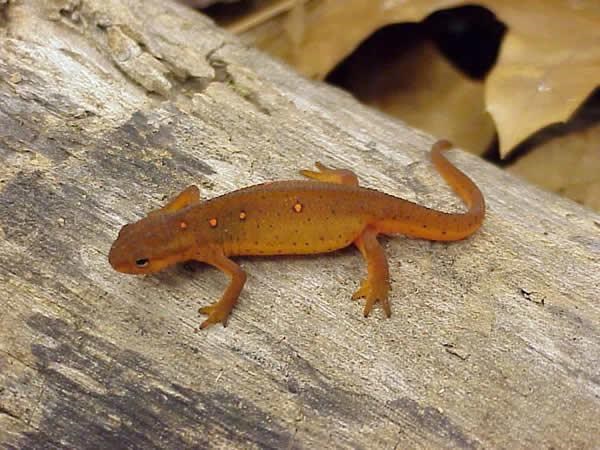
JD Wilson Family: Salamandridae Notophthalmus viridescens Eastern Newt
Size: 5.7 to 14 cm long (2 ¼" to 5 ½") General Description: May be found in both aquatic and terrestrial forms. Yellowish-brown or olive green to dark brown back and yellow belly on aquatic adults. Small black spots scattered on both back and belly. May have a series of red spots, bordered in black, that run down the back of the body. Terrestrial form, also called a Red Eft, is orange-red to reddish brown in color and varies in size from 1 ¼" to 3 ½" (3.4 to 8.7 cm). Costal grooves are indistinct. Hind legs of male enlarged, tail broadly keeled and horny structures on inner thigh surface and toe tips found during mating season. Tail length is approximately half of total body length. May be found in several distinct morphological states including embryo or egg, pond-type larvae, aquatic juvenile with lungs or gills, aquatic adult with lungs or gills, and terrestrial juvenile (efts) or adult with lungs. Reproduction: Breeds fall to early summer. Eggs are typically laid in spring. Habitat: Commonly found foraging in shallow water, quiet stretches or backwaters of streams, swamps or ditches, among lakes and ponds with dense submerged vegetation or in near by damp woodlands. Behavior: Aquatic adults will forage about the pond or water body throughout the day, typically preferring to feed among vegetation near the shore. The efts may be seen walking on the forest floor in broad daylight. Often they are seen in larger numbers after summer rain storms foraging for food among leaf litter. At all life stages this species produces a toxic skin secretion used to deter predators, although the red efts are typically more toxic than adults or their aquatic counterparts. The toxin may even be strong enough to kill certain predators. Defensive posturing includes the "unken" posture in which the animal will bend its head and tail upwards with the tail curled around and the eyes closed and depressed. According to information in Salamanders of the U.S. and Canada by James W. Petranka, studies have shown they are most active during rainy periods when it is warmer than 53º F (12º C) and they tend to hide under leaf litter when dry weather. Research has also indicated it may take up to a year for an eft to migrate 800 m into woodlands near the pond it was born in and the home range of a terrestrial eft is, on average, about 270 m². They tend to spend time close to tree bases or stumps in spring, temporary pools in early summer, and decaying mushrooms in late summer, moving about within their home range mostly based on shifts in food sources. The life history of this species is one of the more complicated ones. The eggs hatch into aquatic, pond-type larvae. The larvae may transform into the terrestrial juvenile (eft) or may mature directly into adults that either have lungs or retain their gills and associated structures. Terrestrial efts may live several years on land and then return to the breeding site to mature into aquatic adults (with lungs) or may sometimes transform into terrestrial adults. Under drought conditions aquatic adults may move into terrestrial habitats, but typically return when conditions improve. Adults show strong loyalty to the pond in which they were born and return to the same pond after time on land or even if they are transplanted to an adjoining pond.
|
Last updated: April 14, 2015
